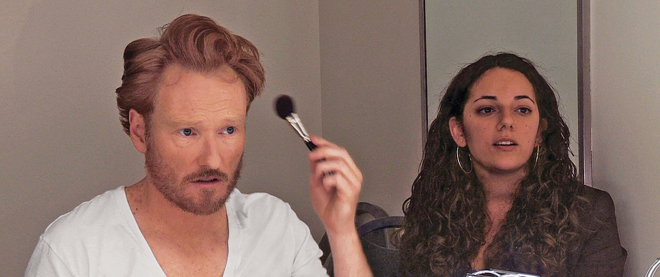Conan and the Grey Lady fight for their lives
A pair of backstage documentaries penetrate O’Brien’s green room and the New York Times newsroom
Filmswelike
Share

“Inside” is a word cherished by the media. It holds the promise of being taken behind the velvet curtain and ushered into a secret world—a celebrity life, a political campaign or a war. Now two compelling backstage documentaries take us inside the media itself: Page One: Inside the New York Times explores the embattled newsroom of America’s most august newspaper, while Conan O’Brien Can’t Stop tracks an angst-ridden comedy tour by a defrocked talk show host. Both are tales of old school underdogs struggling to reinvent themselves in a media landscape where they’ve become an endangered species.
Page One is the more complex and ambitious picture. Director Andrew Rossi spent 14 months shooting in the newsroom of the Grey Lady (whose walls are now lipstick red), “embedded” at the paper’s media desk. The result is a kind of meta-documentary: it tells the story of the Times fighting to survive the social media revolution through the prism of the paper’s own coverage of it. The narrative covers an epic sweep of events, from dire predictions in 2009 that the Times could go bankrupt to its unholy alliance with WikiLeaks and the dawn of the iPad—two game-changing events that promised to render old media obsolete, yet ended up creating rich new opportunities for the newspaper.
A documentary is only as good as its characters, and Page One enlivens its heavy agenda with a diverting ensemble of personalities, led by pugnacious Times media columnist David Carr—a former crack addict whose own survival is as miraculous as that of the paper itself. The film, in fact, originated when director Andrew Rossi interviewed Carr for a documentary he planned to do on Internet entrepreneurs. “The lightbulb went off in my head,” Rossi told Maclean’s. “I said to David, ‘What about doing a movie about you, looking over your shoulder as you report on disruptions in the media landscape?’ He said, ‘You’ll have to speak to my bosses’—assuming that would lead to a big fat no.” But after months of discussions, Bill Keller, then editor of the Times, gave Rossi unprecedented access.
As the attack dog at the heart of the film, Carr defends the Times with a quixotic passion and fierce wit. On a panel debating Michael Wolff, founder of the Web aggregator Newser, he holds up a sheet of paper showing a grid of its media sources, with all the print outlets scissored out. What’s left is just a tatter of perforations. As the man holding Carr’s leash, media editor Bruce Headlam, a Canadian, conveys a shrewd charm. Carr “seems very iconoclastic,” he told Maclean’s, “but he’s imbued with a Times virus, so he’s shockingly traditional in many ways.” So is the film. As it captures various newsroom dramas—the impact of layoffs, the storm over WikiLeaks, a Carr investigation into sexual harrassment at Tribune Co.—it exudes a Times-like authority and scope. “The journalistic rigour that we see the Times demonstrate,” says Rossi, “is something we wanted to live up to.”
In the same vein, Conan O’Brien Can’t Stop emulates the renegade spirit of its subject by trying to show him in an unvarnished light. In the wake of his painful departure from NBC, O’Brien launches his Legally Prohibited from Being Funny on Television tour as a vaudeville mix of comedy and garage band rock. After 16 years at NBC, it’s like a cathartic divorce party. Director Rodman Felder, O’Brien’s pal since college, insists he didn’t want to do a “puff piece.” So we see the comedian being snippy with his staff, and losing patience with the “meet and greet” grind of backstage schmoozing in a 32-city tour. But Conan is so compulsively funny that even his irritation is leavened with self-deprecating charm, as if he can never forget the camera is running.
Both Conan and Page One are classic examples of the vérité style pioneered four decades ago in rockumentaries by D.A. Pennebaker (Don’t Look Back) and the Maysles brothers (Gimme Shelter), two directors Felder cites as influences. Carr and O’Brien are raging pundits who act like rock stars—smartass virtuosos of observational wit. The documentary camera may try to keep its distance. But in the unfiltered honesty of these old school anti-heroes, it seems to have found a kindred spirit.